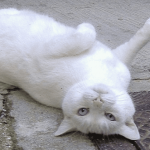 Weird Stuff
Weird Stuff  Weird Stuff
Weird Stuff  Politics
Politics 10 Political Scandals That Sent Crowds Into the Streets
 Weird Stuff
Weird Stuff Ten Bizarre Facts About The Doge Meme
 Our World
Our World 10 Ways Your Christmas Tree Is More Lit Than You Think
 Movies and TV
Movies and TV The 10 Coolest Stars to Set Sail on The Love Boat
 History
History 10 Things You Didn’t Know About the American National Anthem
 Technology
Technology Top 10 Everyday Tech Buzzwords That Hide a Darker Past
 Humans
Humans 10 Everyday Human Behaviors That Are Actually Survival Instincts
 Animals
Animals 10 Animals That Humiliated and Harmed Historical Leaders
 History
History 10 Most Influential Protests in Modern History
 Weird Stuff
Weird Stuff 10 Funny Ways That Researchers Overthink Christmas
 Politics
Politics 10 Political Scandals That Sent Crowds Into the Streets
 Weird Stuff
Weird Stuff Ten Bizarre Facts About The Doge Meme
Who's Behind Listverse?

Jamie Frater
Head Editor
Jamie founded Listverse due to an insatiable desire to share fascinating, obscure, and bizarre facts. He has been a guest speaker on numerous national radio and television stations and is a five time published author.
More About Us Our World
Our World 10 Ways Your Christmas Tree Is More Lit Than You Think
 Movies and TV
Movies and TV The 10 Coolest Stars to Set Sail on The Love Boat
 History
History 10 Things You Didn’t Know About the American National Anthem
 Technology
Technology Top 10 Everyday Tech Buzzwords That Hide a Darker Past
 Humans
Humans 10 Everyday Human Behaviors That Are Actually Survival Instincts
 Animals
Animals 10 Animals That Humiliated and Harmed Historical Leaders
 History
History 10 Most Influential Protests in Modern History
Ten Animal Facts That Simply Don’t Seem Real–but Are
There is no shortage of fascinating facts about the animal kingdom. All over the world, animals of all kinds have developed incredible evolutionary adaptations over millions of years. From small insects, spiders, fish, and other minuscule creatures to some of the biggest animals in the world, each species has its own unique story.
So, in this list, we’ll take some time to celebrate a few of those fascinating animal facts. These tidbits are nearly impossible to believe, and at first glance, you might dismiss them as phony. But every single one of them is true! Science has proven these unlikely faunal facts beyond the shadow of a doubt… and now you can wow your pals with this new knowledge about the wild world around us!
Related: Top 10 Animals With Creepy Behaviors
10 Eyes over Brains (Literally)
The ostrich is the world’s biggest bird, and it also has some of the biggest eyes in the entire animal kingdom. In fact, the ostrich’s eyes are so big that they are actually bigger than their brains! Each eye measures about two inches (or roughly five centimeters) in diameter on average. That’s just about the size of a billiard ball you’d find in a pool hall. But for an ostrich, two of those things crammed into its tiny head make for some seriously powerful sight. Heck, when you think about it, maybe it’s no wonder that the ostrich’s eyes are bigger than its brain; there simply isn’t any more room left to fit a brain inside that small dome!
The reason ostriches have such large eyes (and such comparatively small brains) is, like anything, the result of a long evolutionary process. For the ostrich, powerful vision is critical to staying alive. With an unusually high number of photoreceptor cells within their eyeballs and some uniquely efficient processing power that sends images to those tiny brains, the ostrich can see predators clearly from very far away. And when it does, its other massive evolutionary adaptation comes in: its long, strong legs. As flightless birds, ostriches sprint instead of flying away upon seeing predators, crediting their eyes more than their brains for allowing them to live another day.[1]
9 Bundles of Broken Bones
We don’t often think about it, but it makes perfect sense that animals would regularly break bones out in the wild. They run, jump, chase prey, scurry from predators, climb, and inevitably get injured. Depending on the animal in question, falls from trees and ledges or tumbles down hills and ravines can be frequent, if not common. So it’s not particularly surprising to learn that a high proportion of wild animals suffer broken bones during their lifetimes.
For some, it can spell a death sentence as predators descend on the wounded creature. For others, depending on the severity of the break, these bones can slowly (and imperfectly) heal, allowing the animal to live on into relatively old age. And for orangutans, these breaks are so common that researchers practically expect to see them in wild subjects they observe and study.
According to some estimates, at least fifty percent of adult orangutans have one or several fractured bones somewhere in their body. These monkeys are agile, strong, and adept at swinging across tree branches and climbing through canopies. But that doesn’t mean they are perfect. In fact, orangutans very often fall out of trees. And when they do, many suffer severe bone fractures when they hit the ground. The lucky ones are left relatively less scathed and can nurse the injury into a ton of scar tissue after weeks of pain.[2]
8 Sloths Are Slow at Everything
Sloths take their time in just about every phase of their life. Obviously, it’s well-documented that they don’t move very quickly when going up and down trees and high above in branches. That can put them at peril when they have to go down to the ground, but up above in the canopy, they can stay there safely and hang out—literally. Movement isn’t the only slow aspect of a sloth’s life, though. Digestion is exceptionally slow, too! While the animal creeps along at a glacial pace through the forest, its digested food creeps equally slowly through its insides.
For reference, the average human typically digests each meal in roughly 12 to 24 hours, with some people experiencing a full digestion cycle a bit longer than that. From there, excess waste is eliminated, and we move on. Sloths stretch that process out to interminable lengths, though! The average sloth takes more than two weeks to fully digest each meal. And scientists have found that in the most extreme, sloths can go through the digestion process for up to 30 days!
The reason for that is evolutionary. For sloths, coming down from the treetops is a dangerous time. They would prefer to stay up high and away from predators. So their digestion slows to ensure they don’t have to use, umm, the forest facilities very often. They can hold it in for a long, long time, basically. When they come down to relieve themselves—which is only about once a week on average—they can lose up to a third of their body weight. Then, it’s back up into the trees to hang out and process food slowly once more![3]
7 Elephants Can’t Jump, but…
Elephants can’t jump. They are too heavy, and their bodies are designed so that it’s impossible for them to lift all four feet off the ground at once—even when they are stampeding. Consider their fastest run as some sort of version of speed-walking, then. But this isn’t the animal fact that we’re covering here. In fact, most “facts” you’ll read out there across the internet claim elephants are the only mammals that can’t jump. But that’s simply not true!
In reality, lots of mammals cannot jump. Also on that list of land-bound creatures are the rhino, the hippo, the sloth, and many more. The difference with them, however, is that both rhinos and hippos can get all four feet off the ground when running at top speed, unlike elephants. (And, technically, we suppose hippos have all four feet off the ground while they’re floating along in rivers and lakes, too!) So the next time you hear somebody try to claim elephants are unique in the mammal realm for their inability to hop, you can correct them with this actually true animal update instead.[4]
6 Giraffes Are Mute… Maybe
Giraffes have a larynx just like every other mammal on Earth, but they don’t use it to make discernible noises. For decades, scientists have assumed that’s because of their long, narrow tracheas and relatively small lung capacities. As the theory went, giraffes had the parts to “talk” but simply couldn’t produce vocal noises because it was too difficult on their infamously long necks. And since researchers spent thousands of hours around the beautiful beasts in zoos and the wild while never hearing them do more than snort through their nostrils, that was settled science… until 2015.
That year, scientists announced that giraffes actually do “talk” in their own way. But instead of using airflow to vibrate their vocal cords like other animals (and humans), they simply emit a high-frequency hum. The sound is similar in practice to what the giraffe’s close relative, the okapi, produces. And it is far too low for humans to hear naturally. So biologists had to set up special sound recording equipment in zoos and spend countless hours analyzing hundreds of hours of tapes. But the hum is there! Giraffes do communicate with each other. They just don’t use their vocal cords, and thus can’t “talk” like the barks, roars, squeaks, and sounds of other mammals.[5]
5 The Koala Did It!
Koalas and humans have fingerprints that are nearly indistinguishable from each other. This is part of a process that scientists call “convergent evolution,” which is not as uncommon as you might think in the animal kingdom. But for this specific trait—the nearly identical fingerprints between us and the adorable marsupials—the backstory is a little bit weird. For one, researchers believe that the last common ancestor we shared with koalas lived and died out well over 100 million years ago. So the fact that we should have such closely designed fingerprints as the adorable tree-hugger is fascinating on its own.
And you may be wondering: how similar are our prints, anyway? Koalas’ fingers are marked so closely to humans that Australian police officials have been wondering for years whether a slew of unmarked fingerprints listed in crime databases actually belong to the marsupials! Like in many other countries, law enforcement officials around Australia have been marking and recording fingerprints found at crime scenes for decades now. They have compiled a massive database, and when they get fingerprints from new crimes, they search to see if they “hit” on old ones.
Pretty standard stuff, right? But there are tons of unmatched fingerprints in the database now—so many, in fact, that officials wonder whether a not-insignificant portion of these mystery prints belongs to koalas. Fingerprint technicians collected them, assuming they were human prints, and database managers logged them for the same reason. So there’s your answer: That is how closely matched koala fingerprints are to our own![6]
4 Liquid in Means Liquid Out
Healthy cows live their lives in a very productive fashion. The average lactating dairy industry cow produces somewhere around 6-7 gallons (22.7-26.5 liters) of milk every single day. That totals up to more than 2,000 gallons (7,570 liters) of milk per cow per year for the healthiest Holsteins.
When you take into account a cow’s “career” producing milk, factor in however many cycles of birth they are subjected to, and consider their average age of slaughter for meat (sad!), dairy industry experts estimate that the average American cow will produce more than 11,000 gallons (155,202 liters) of milk in their lifetime. That turns into a bit more than 200,000 cups (48,000 liters) of the stuff. And that’s a lot of milk mustaches!
Of course, some cows are the exceptions that prove the rule. One notoriously productive Wisconsin cow named Hilda produced more than 50,000 gallons (189,271 liters) of milk during her lifetime. She did many bodies good—to riff off the iconic old milk advertisement.
To get to those numbers in peak production, Hilda and other cows need a lot of resources from farmers. That means plenty of food to chew and chew and chew throughout their lives. And it also means a lot of water to drink to stay hydrated and healthy. And we’re not kidding about that; the average cow drinks nearly 50 gallons (189.3 liters) of water every single day. Lots of liquid in, lots of liquid out, and dairy continues to rule the agricultural world![7]
3 Snails Sleep In
What’s the longest you’ve ever slept in on a weekend day? Noon? Later than that? Some people love to hit snooze and doze off for as long as their bodies will allow, especially on weekends while trying to catch up on rest. But whatever your answer about sleeping in may be, we can guarantee that snails have you beat. That’s because snails don’t just doze for hours on end… or days… or even months. Amazingly, they have been known to sleep for years at a time when the situation calls for it!
Snails need moisture to thrive and survive. They’ll often come out in the early mornings in many environments when dew is on the grass and plants. They’ll leave their little trails and slither along, doing their thing in peace. But when the weather doesn’t cooperate with that need for moisture, snails intuitively know when to shut it down.
In dry and otherwise harsh conditions, snails shift into two different modes of hibernation. One is the normal wintertime sleep that other animals (like bears) are also famous for. The other is called “estivation,” which occurs during the summer and allows snails to sleep through the hottest, most uncomfortable months. But it’s the timing that will really shock you: Under the right—or wrong—conditions, snails will shut down and hibernate for up to three years at a time! Whatever it takes to wait for appropriate moisture, we suppose…[8]
2 A Continent of Penguin Pee?
Just like our non-jumping elephant friends up top, there is another fact floating around the internet that seems too good to be true. This one is a little more disgusting, too. As the story goes, 3% of Antarctica’s ice supposedly is frozen penguin pee. The glaciers are in a really cold spot on Earth, of course, and when penguins pee on them, the temperature is so low that the urine can’t evaporate like it would in a normal climate. Very quickly, the pee freezes up as part of the ice, and over time, the entire continent is just one big frozen block of ice pee. Gross, right?
Well, yes—if it were true! Like all other birds, penguins don’t actually pee the way we recognize it in most other animals. They don’t have a urethra or even a bladder. And instead of converting their waste into urea, penguins transition it to uric acid. Then, like other birds, penguins secrete that waste product simultaneously with their poop. The end result is that patented white-colored pasty bird dropping that we all know too well from one (or many) close encounters with pigeons. So, no, penguin pee does not account for 3% of Antarctica’s ice shelf, as many claim. And now you know why![9]
1 Hold My Heart in Your… Head?
For most creatures, the heart is located somewhere in the chest or mid-section of the body. Just like with humans, most animals have their hearts protected by a rib cage, a thorax, or something similar. There are usually a lot of vital organs clumped together in there, too. After all, evolution has dictated they be veiled by whatever natural defense their bodies can muster. But not with shrimp!
In shrimp, the heart is located up in the head. And that’s not the only vital organ that finds itself perched precariously by the animal’s brain. The crustacean also holds multiple other organs in its head, including its stomach and ventral nerve cord. The reason why that’s the case is a little complicated. Basically, instead of a “normal” thorax, shrimp have what’s called a cephalothorax. That’s what happens when the thorax merges with the head to create a new region to… well, host and shepherd the animal’s life. In turn, the cephalothorax is critical for shrimp because its position and size allow the creature to stay balanced while swimming.
All that is protected by an exoskeleton, common among many insects, crustaceans, and other creatures. But here’s the other cool part about shrimp hearts: They have three valves instead of two! While humans and many other land-going species have just one entrance and exit from the ventricle to pump blood, crustaceans need more than that in order to stay oxygenated and alive underwater. Simply put, shrimp hearts are very complicated… even if shrimp cocktails are not![10]








